Business Ventures: Funding, Challenges, and Risk Management Report
VerifiedAdded on 2021/05/31
|12
|3125
|33
Report
AI Summary
This report provides a comprehensive overview of business ventures, focusing on the sources of capital, the challenges faced by new ventures, and potential solutions to mitigate risks. It delves into various funding options, including bank loans, government programs, private investors, and venture capital, analyzing their advantages and disadvantages. The report identifies and categorizes the key challenges that new ventures encounter, such as legal, technological, economic, social, cultural, political, and environmental issues. It examines specific problems within each category, from choosing the right business organization to keeping up with technological advancements and navigating economic downturns. The report also explores potential solutions to these challenges, emphasizing the importance of risk management, strategic planning, and adapting to the ever-changing business environment. The report concludes by highlighting the importance of government support and the need for entrepreneurs to be adaptable and resilient in the face of adversity. The report emphasizes the importance of a well-defined risk management plan to identify and mitigate the potential hazards that businesses may face.

Running head: NEW BUSINESS VENTURES 1
Business Ventures
Name
Affiliate Institution
Business Ventures
Name
Affiliate Institution
Paraphrase This Document
Need a fresh take? Get an instant paraphrase of this document with our AI Paraphraser
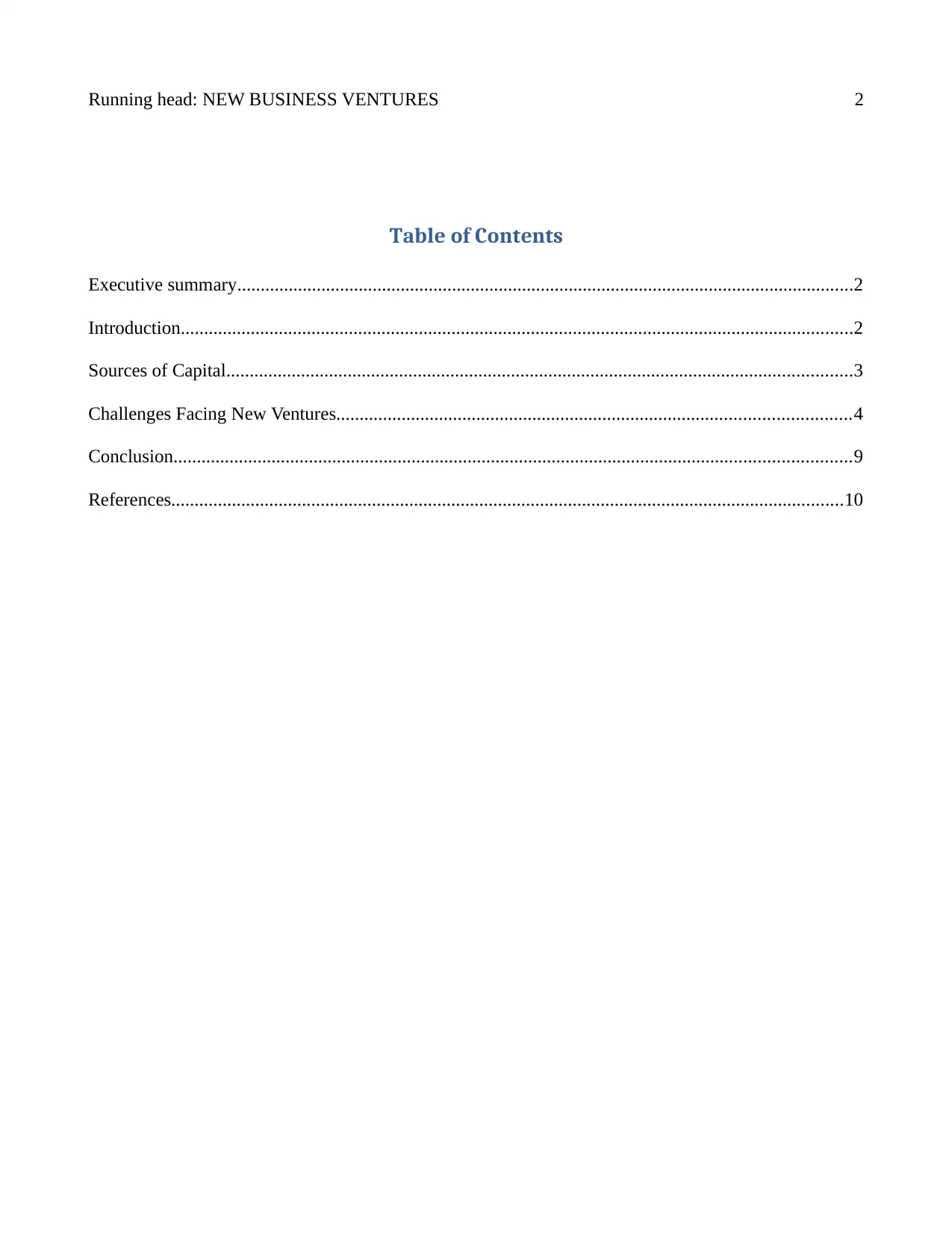
Running head: NEW BUSINESS VENTURES 2
Table of Contents
Executive summary....................................................................................................................................2
Introduction................................................................................................................................................2
Sources of Capital......................................................................................................................................3
Challenges Facing New Ventures..............................................................................................................4
Conclusion.................................................................................................................................................9
References................................................................................................................................................10
Table of Contents
Executive summary....................................................................................................................................2
Introduction................................................................................................................................................2
Sources of Capital......................................................................................................................................3
Challenges Facing New Ventures..............................................................................................................4
Conclusion.................................................................................................................................................9
References................................................................................................................................................10
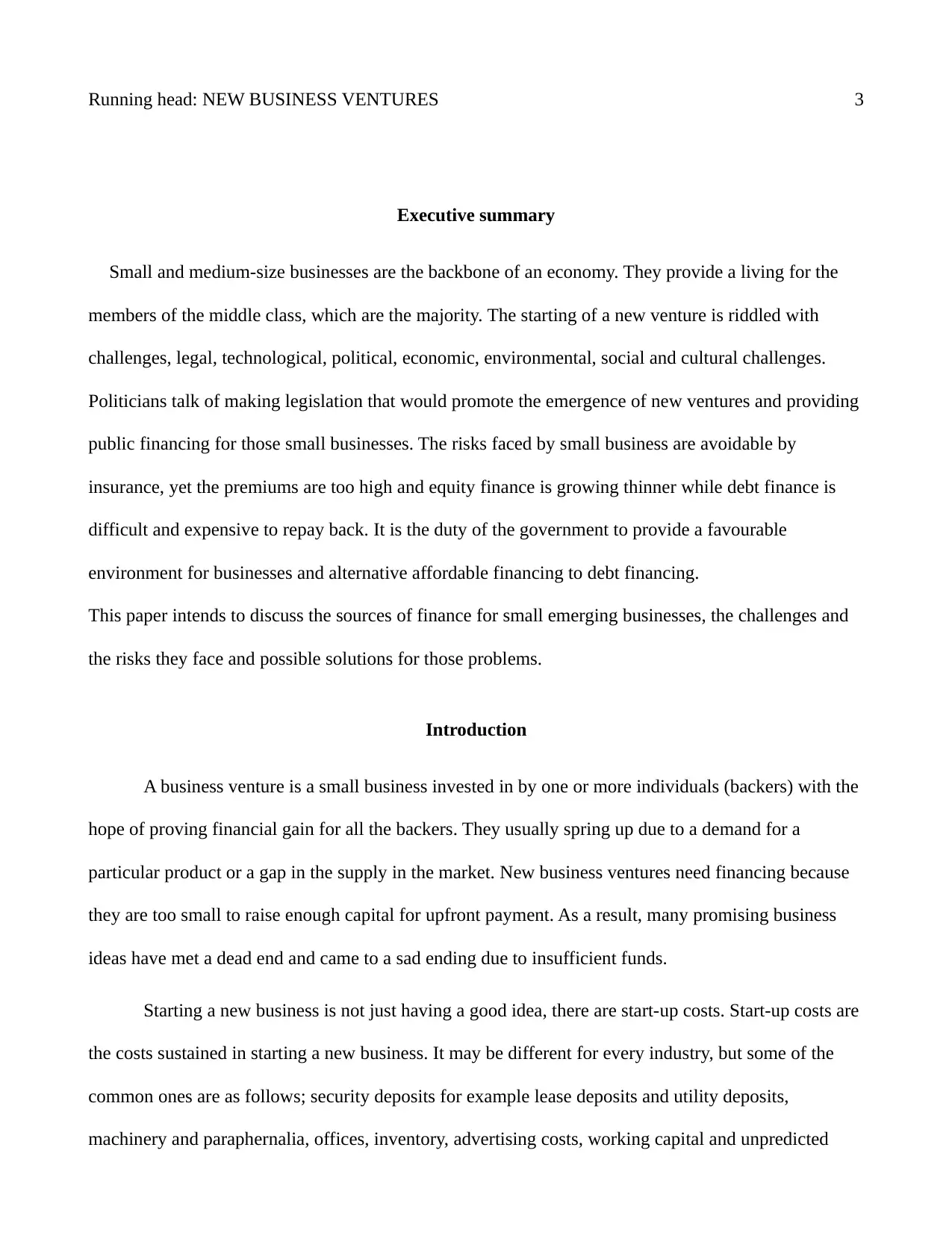
Running head: NEW BUSINESS VENTURES 3
Executive summary
Small and medium-size businesses are the backbone of an economy. They provide a living for the
members of the middle class, which are the majority. The starting of a new venture is riddled with
challenges, legal, technological, political, economic, environmental, social and cultural challenges.
Politicians talk of making legislation that would promote the emergence of new ventures and providing
public financing for those small businesses. The risks faced by small business are avoidable by
insurance, yet the premiums are too high and equity finance is growing thinner while debt finance is
difficult and expensive to repay back. It is the duty of the government to provide a favourable
environment for businesses and alternative affordable financing to debt financing.
This paper intends to discuss the sources of finance for small emerging businesses, the challenges and
the risks they face and possible solutions for those problems.
Introduction
A business venture is a small business invested in by one or more individuals (backers) with the
hope of proving financial gain for all the backers. They usually spring up due to a demand for a
particular product or a gap in the supply in the market. New business ventures need financing because
they are too small to raise enough capital for upfront payment. As a result, many promising business
ideas have met a dead end and came to a sad ending due to insufficient funds.
Starting a new business is not just having a good idea, there are start-up costs. Start-up costs are
the costs sustained in starting a new business. It may be different for every industry, but some of the
common ones are as follows; security deposits for example lease deposits and utility deposits,
machinery and paraphernalia, offices, inventory, advertising costs, working capital and unpredicted
Executive summary
Small and medium-size businesses are the backbone of an economy. They provide a living for the
members of the middle class, which are the majority. The starting of a new venture is riddled with
challenges, legal, technological, political, economic, environmental, social and cultural challenges.
Politicians talk of making legislation that would promote the emergence of new ventures and providing
public financing for those small businesses. The risks faced by small business are avoidable by
insurance, yet the premiums are too high and equity finance is growing thinner while debt finance is
difficult and expensive to repay back. It is the duty of the government to provide a favourable
environment for businesses and alternative affordable financing to debt financing.
This paper intends to discuss the sources of finance for small emerging businesses, the challenges and
the risks they face and possible solutions for those problems.
Introduction
A business venture is a small business invested in by one or more individuals (backers) with the
hope of proving financial gain for all the backers. They usually spring up due to a demand for a
particular product or a gap in the supply in the market. New business ventures need financing because
they are too small to raise enough capital for upfront payment. As a result, many promising business
ideas have met a dead end and came to a sad ending due to insufficient funds.
Starting a new business is not just having a good idea, there are start-up costs. Start-up costs are
the costs sustained in starting a new business. It may be different for every industry, but some of the
common ones are as follows; security deposits for example lease deposits and utility deposits,
machinery and paraphernalia, offices, inventory, advertising costs, working capital and unpredicted
⊘ This is a preview!⊘
Do you want full access?
Subscribe today to unlock all pages.

Trusted by 1+ million students worldwide
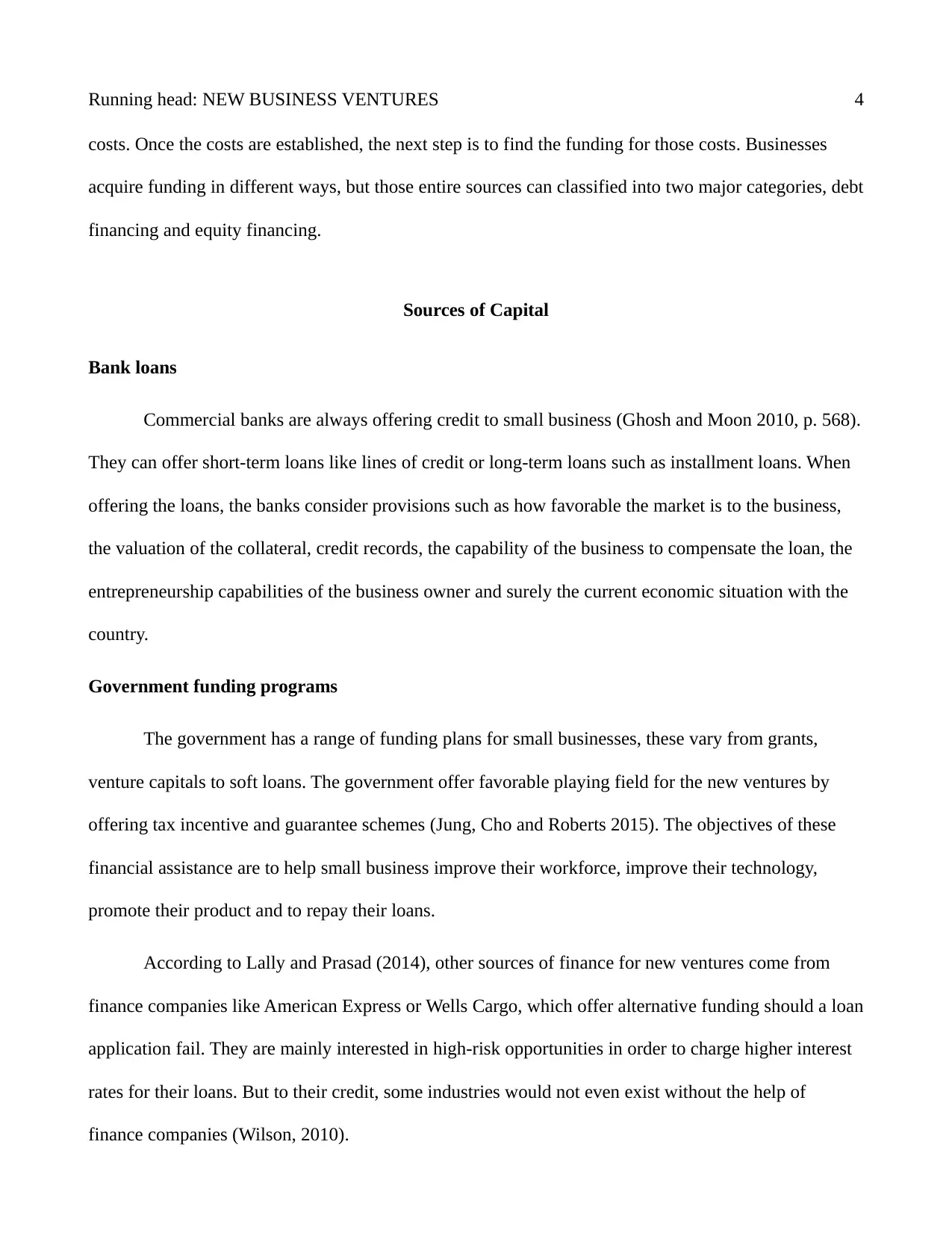
Running head: NEW BUSINESS VENTURES 4
costs. Once the costs are established, the next step is to find the funding for those costs. Businesses
acquire funding in different ways, but those entire sources can classified into two major categories, debt
financing and equity financing.
Sources of Capital
Bank loans
Commercial banks are always offering credit to small business (Ghosh and Moon 2010, p. 568).
They can offer short-term loans like lines of credit or long-term loans such as installment loans. When
offering the loans, the banks consider provisions such as how favorable the market is to the business,
the valuation of the collateral, credit records, the capability of the business to compensate the loan, the
entrepreneurship capabilities of the business owner and surely the current economic situation with the
country.
Government funding programs
The government has a range of funding plans for small businesses, these vary from grants,
venture capitals to soft loans. The government offer favorable playing field for the new ventures by
offering tax incentive and guarantee schemes (Jung, Cho and Roberts 2015). The objectives of these
financial assistance are to help small business improve their workforce, improve their technology,
promote their product and to repay their loans.
According to Lally and Prasad (2014), other sources of finance for new ventures come from
finance companies like American Express or Wells Cargo, which offer alternative funding should a loan
application fail. They are mainly interested in high-risk opportunities in order to charge higher interest
rates for their loans. But to their credit, some industries would not even exist without the help of
finance companies (Wilson, 2010).
costs. Once the costs are established, the next step is to find the funding for those costs. Businesses
acquire funding in different ways, but those entire sources can classified into two major categories, debt
financing and equity financing.
Sources of Capital
Bank loans
Commercial banks are always offering credit to small business (Ghosh and Moon 2010, p. 568).
They can offer short-term loans like lines of credit or long-term loans such as installment loans. When
offering the loans, the banks consider provisions such as how favorable the market is to the business,
the valuation of the collateral, credit records, the capability of the business to compensate the loan, the
entrepreneurship capabilities of the business owner and surely the current economic situation with the
country.
Government funding programs
The government has a range of funding plans for small businesses, these vary from grants,
venture capitals to soft loans. The government offer favorable playing field for the new ventures by
offering tax incentive and guarantee schemes (Jung, Cho and Roberts 2015). The objectives of these
financial assistance are to help small business improve their workforce, improve their technology,
promote their product and to repay their loans.
According to Lally and Prasad (2014), other sources of finance for new ventures come from
finance companies like American Express or Wells Cargo, which offer alternative funding should a loan
application fail. They are mainly interested in high-risk opportunities in order to charge higher interest
rates for their loans. But to their credit, some industries would not even exist without the help of
finance companies (Wilson, 2010).
Paraphrase This Document
Need a fresh take? Get an instant paraphrase of this document with our AI Paraphraser
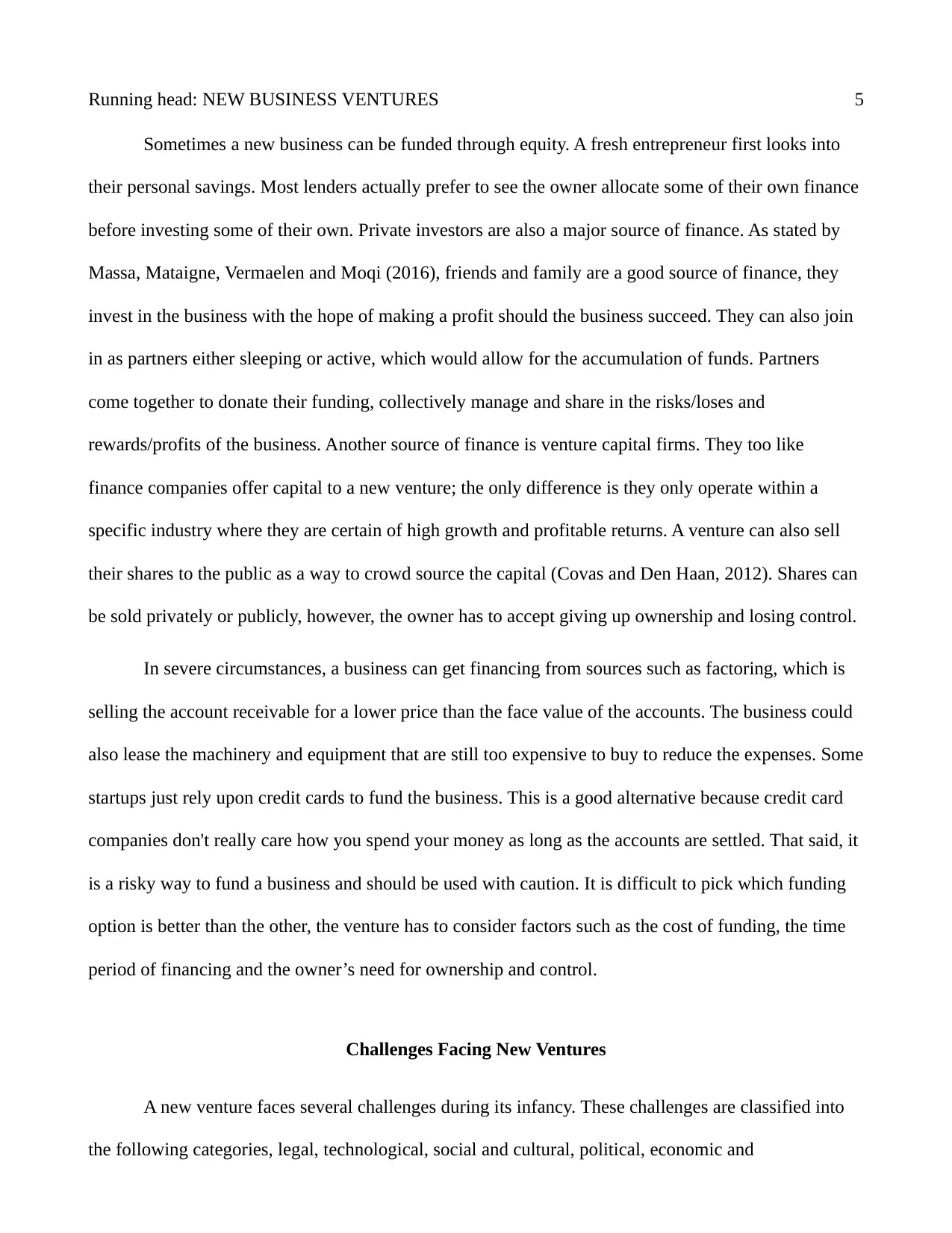
Running head: NEW BUSINESS VENTURES 5
Sometimes a new business can be funded through equity. A fresh entrepreneur first looks into
their personal savings. Most lenders actually prefer to see the owner allocate some of their own finance
before investing some of their own. Private investors are also a major source of finance. As stated by
Massa, Mataigne, Vermaelen and Moqi (2016), friends and family are a good source of finance, they
invest in the business with the hope of making a profit should the business succeed. They can also join
in as partners either sleeping or active, which would allow for the accumulation of funds. Partners
come together to donate their funding, collectively manage and share in the risks/loses and
rewards/profits of the business. Another source of finance is venture capital firms. They too like
finance companies offer capital to a new venture; the only difference is they only operate within a
specific industry where they are certain of high growth and profitable returns. A venture can also sell
their shares to the public as a way to crowd source the capital (Covas and Den Haan, 2012). Shares can
be sold privately or publicly, however, the owner has to accept giving up ownership and losing control.
In severe circumstances, a business can get financing from sources such as factoring, which is
selling the account receivable for a lower price than the face value of the accounts. The business could
also lease the machinery and equipment that are still too expensive to buy to reduce the expenses. Some
startups just rely upon credit cards to fund the business. This is a good alternative because credit card
companies don't really care how you spend your money as long as the accounts are settled. That said, it
is a risky way to fund a business and should be used with caution. It is difficult to pick which funding
option is better than the other, the venture has to consider factors such as the cost of funding, the time
period of financing and the owner’s need for ownership and control.
Challenges Facing New Ventures
A new venture faces several challenges during its infancy. These challenges are classified into
the following categories, legal, technological, social and cultural, political, economic and
Sometimes a new business can be funded through equity. A fresh entrepreneur first looks into
their personal savings. Most lenders actually prefer to see the owner allocate some of their own finance
before investing some of their own. Private investors are also a major source of finance. As stated by
Massa, Mataigne, Vermaelen and Moqi (2016), friends and family are a good source of finance, they
invest in the business with the hope of making a profit should the business succeed. They can also join
in as partners either sleeping or active, which would allow for the accumulation of funds. Partners
come together to donate their funding, collectively manage and share in the risks/loses and
rewards/profits of the business. Another source of finance is venture capital firms. They too like
finance companies offer capital to a new venture; the only difference is they only operate within a
specific industry where they are certain of high growth and profitable returns. A venture can also sell
their shares to the public as a way to crowd source the capital (Covas and Den Haan, 2012). Shares can
be sold privately or publicly, however, the owner has to accept giving up ownership and losing control.
In severe circumstances, a business can get financing from sources such as factoring, which is
selling the account receivable for a lower price than the face value of the accounts. The business could
also lease the machinery and equipment that are still too expensive to buy to reduce the expenses. Some
startups just rely upon credit cards to fund the business. This is a good alternative because credit card
companies don't really care how you spend your money as long as the accounts are settled. That said, it
is a risky way to fund a business and should be used with caution. It is difficult to pick which funding
option is better than the other, the venture has to consider factors such as the cost of funding, the time
period of financing and the owner’s need for ownership and control.
Challenges Facing New Ventures
A new venture faces several challenges during its infancy. These challenges are classified into
the following categories, legal, technological, social and cultural, political, economic and
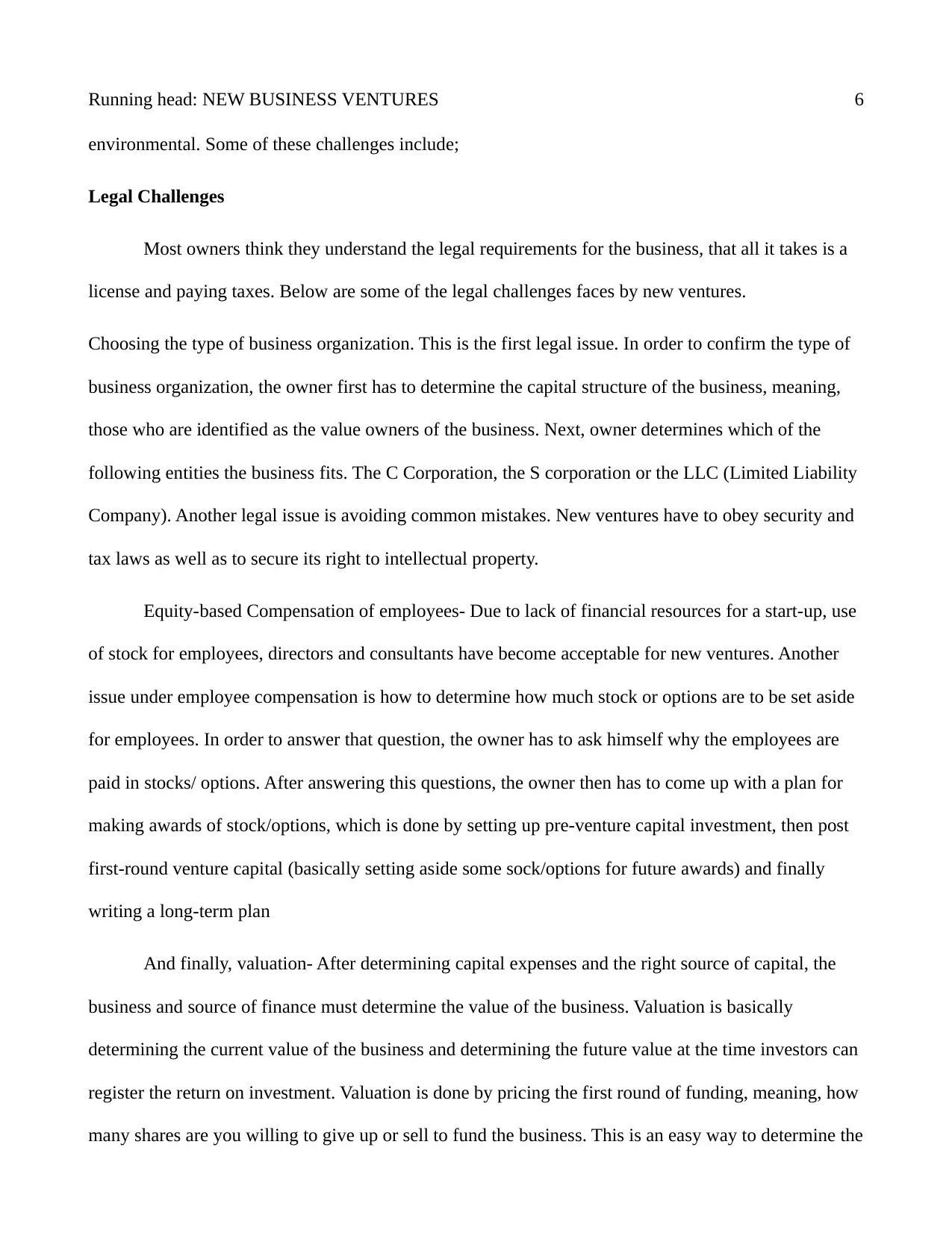
Running head: NEW BUSINESS VENTURES 6
environmental. Some of these challenges include;
Legal Challenges
Most owners think they understand the legal requirements for the business, that all it takes is a
license and paying taxes. Below are some of the legal challenges faces by new ventures.
Choosing the type of business organization. This is the first legal issue. In order to confirm the type of
business organization, the owner first has to determine the capital structure of the business, meaning,
those who are identified as the value owners of the business. Next, owner determines which of the
following entities the business fits. The C Corporation, the S corporation or the LLC (Limited Liability
Company). Another legal issue is avoiding common mistakes. New ventures have to obey security and
tax laws as well as to secure its right to intellectual property.
Equity-based Compensation of employees- Due to lack of financial resources for a start-up, use
of stock for employees, directors and consultants have become acceptable for new ventures. Another
issue under employee compensation is how to determine how much stock or options are to be set aside
for employees. In order to answer that question, the owner has to ask himself why the employees are
paid in stocks/ options. After answering this questions, the owner then has to come up with a plan for
making awards of stock/options, which is done by setting up pre-venture capital investment, then post
first-round venture capital (basically setting aside some sock/options for future awards) and finally
writing a long-term plan
And finally, valuation- After determining capital expenses and the right source of capital, the
business and source of finance must determine the value of the business. Valuation is basically
determining the current value of the business and determining the future value at the time investors can
register the return on investment. Valuation is done by pricing the first round of funding, meaning, how
many shares are you willing to give up or sell to fund the business. This is an easy way to determine the
environmental. Some of these challenges include;
Legal Challenges
Most owners think they understand the legal requirements for the business, that all it takes is a
license and paying taxes. Below are some of the legal challenges faces by new ventures.
Choosing the type of business organization. This is the first legal issue. In order to confirm the type of
business organization, the owner first has to determine the capital structure of the business, meaning,
those who are identified as the value owners of the business. Next, owner determines which of the
following entities the business fits. The C Corporation, the S corporation or the LLC (Limited Liability
Company). Another legal issue is avoiding common mistakes. New ventures have to obey security and
tax laws as well as to secure its right to intellectual property.
Equity-based Compensation of employees- Due to lack of financial resources for a start-up, use
of stock for employees, directors and consultants have become acceptable for new ventures. Another
issue under employee compensation is how to determine how much stock or options are to be set aside
for employees. In order to answer that question, the owner has to ask himself why the employees are
paid in stocks/ options. After answering this questions, the owner then has to come up with a plan for
making awards of stock/options, which is done by setting up pre-venture capital investment, then post
first-round venture capital (basically setting aside some sock/options for future awards) and finally
writing a long-term plan
And finally, valuation- After determining capital expenses and the right source of capital, the
business and source of finance must determine the value of the business. Valuation is basically
determining the current value of the business and determining the future value at the time investors can
register the return on investment. Valuation is done by pricing the first round of funding, meaning, how
many shares are you willing to give up or sell to fund the business. This is an easy way to determine the
⊘ This is a preview!⊘
Do you want full access?
Subscribe today to unlock all pages.

Trusted by 1+ million students worldwide
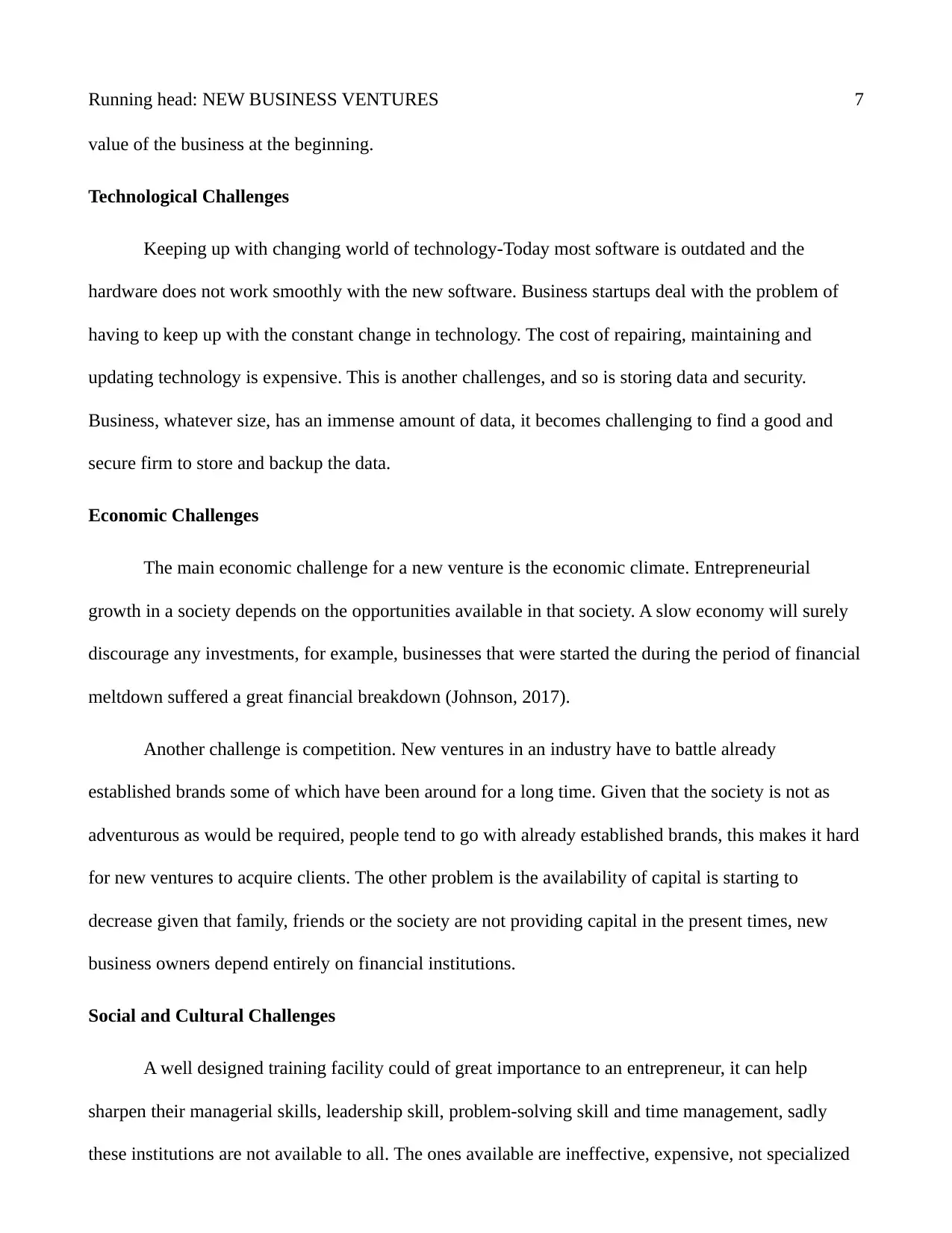
Running head: NEW BUSINESS VENTURES 7
value of the business at the beginning.
Technological Challenges
Keeping up with changing world of technology-Today most software is outdated and the
hardware does not work smoothly with the new software. Business startups deal with the problem of
having to keep up with the constant change in technology. The cost of repairing, maintaining and
updating technology is expensive. This is another challenges, and so is storing data and security.
Business, whatever size, has an immense amount of data, it becomes challenging to find a good and
secure firm to store and backup the data.
Economic Challenges
The main economic challenge for a new venture is the economic climate. Entrepreneurial
growth in a society depends on the opportunities available in that society. A slow economy will surely
discourage any investments, for example, businesses that were started the during the period of financial
meltdown suffered a great financial breakdown (Johnson, 2017).
Another challenge is competition. New ventures in an industry have to battle already
established brands some of which have been around for a long time. Given that the society is not as
adventurous as would be required, people tend to go with already established brands, this makes it hard
for new ventures to acquire clients. The other problem is the availability of capital is starting to
decrease given that family, friends or the society are not providing capital in the present times, new
business owners depend entirely on financial institutions.
Social and Cultural Challenges
A well designed training facility could of great importance to an entrepreneur, it can help
sharpen their managerial skills, leadership skill, problem-solving skill and time management, sadly
these institutions are not available to all. The ones available are ineffective, expensive, not specialized
value of the business at the beginning.
Technological Challenges
Keeping up with changing world of technology-Today most software is outdated and the
hardware does not work smoothly with the new software. Business startups deal with the problem of
having to keep up with the constant change in technology. The cost of repairing, maintaining and
updating technology is expensive. This is another challenges, and so is storing data and security.
Business, whatever size, has an immense amount of data, it becomes challenging to find a good and
secure firm to store and backup the data.
Economic Challenges
The main economic challenge for a new venture is the economic climate. Entrepreneurial
growth in a society depends on the opportunities available in that society. A slow economy will surely
discourage any investments, for example, businesses that were started the during the period of financial
meltdown suffered a great financial breakdown (Johnson, 2017).
Another challenge is competition. New ventures in an industry have to battle already
established brands some of which have been around for a long time. Given that the society is not as
adventurous as would be required, people tend to go with already established brands, this makes it hard
for new ventures to acquire clients. The other problem is the availability of capital is starting to
decrease given that family, friends or the society are not providing capital in the present times, new
business owners depend entirely on financial institutions.
Social and Cultural Challenges
A well designed training facility could of great importance to an entrepreneur, it can help
sharpen their managerial skills, leadership skill, problem-solving skill and time management, sadly
these institutions are not available to all. The ones available are ineffective, expensive, not specialized
Paraphrase This Document
Need a fresh take? Get an instant paraphrase of this document with our AI Paraphraser
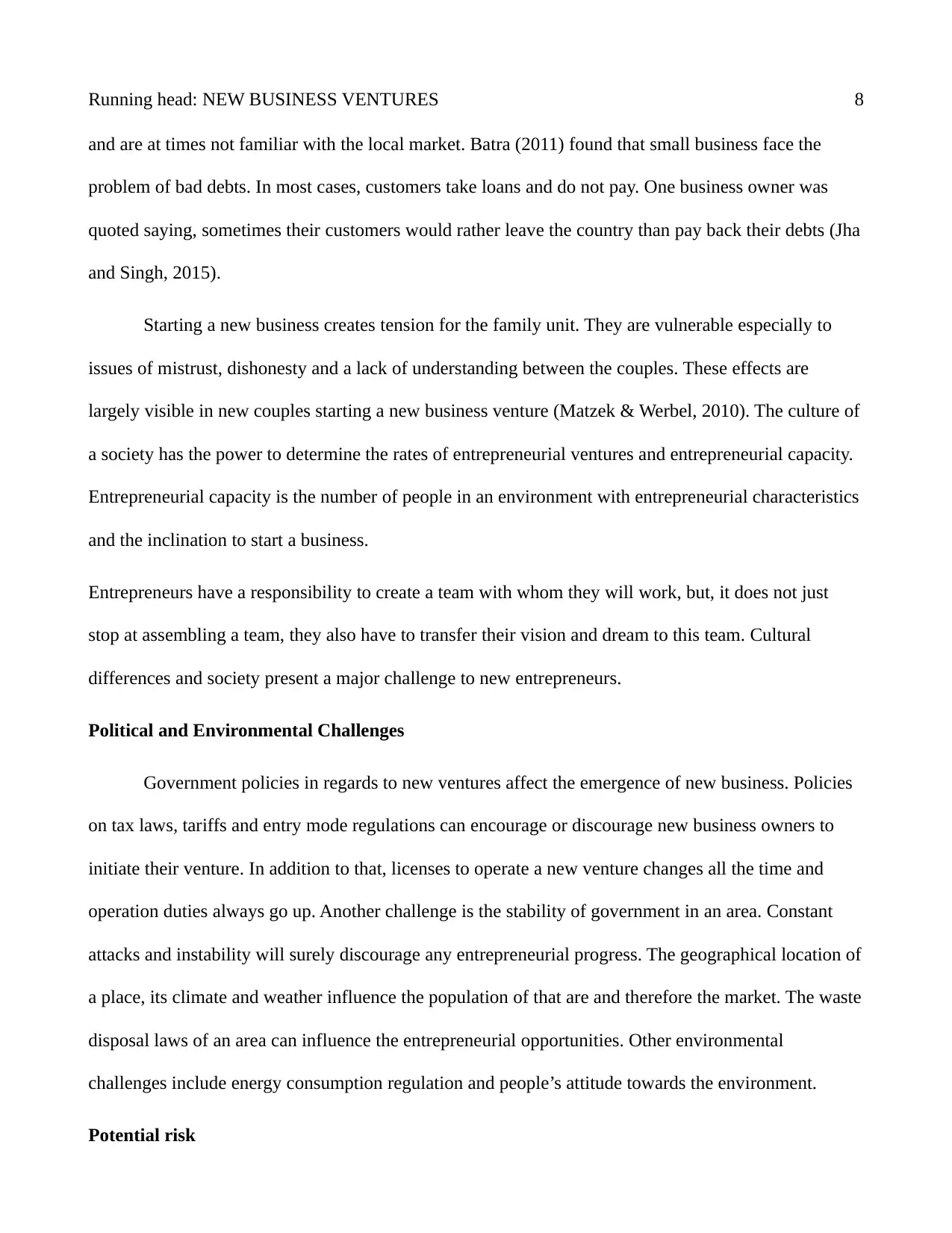
Running head: NEW BUSINESS VENTURES 8
and are at times not familiar with the local market. Batra (2011) found that small business face the
problem of bad debts. In most cases, customers take loans and do not pay. One business owner was
quoted saying, sometimes their customers would rather leave the country than pay back their debts (Jha
and Singh, 2015).
Starting a new business creates tension for the family unit. They are vulnerable especially to
issues of mistrust, dishonesty and a lack of understanding between the couples. These effects are
largely visible in new couples starting a new business venture (Matzek & Werbel, 2010). The culture of
a society has the power to determine the rates of entrepreneurial ventures and entrepreneurial capacity.
Entrepreneurial capacity is the number of people in an environment with entrepreneurial characteristics
and the inclination to start a business.
Entrepreneurs have a responsibility to create a team with whom they will work, but, it does not just
stop at assembling a team, they also have to transfer their vision and dream to this team. Cultural
differences and society present a major challenge to new entrepreneurs.
Political and Environmental Challenges
Government policies in regards to new ventures affect the emergence of new business. Policies
on tax laws, tariffs and entry mode regulations can encourage or discourage new business owners to
initiate their venture. In addition to that, licenses to operate a new venture changes all the time and
operation duties always go up. Another challenge is the stability of government in an area. Constant
attacks and instability will surely discourage any entrepreneurial progress. The geographical location of
a place, its climate and weather influence the population of that are and therefore the market. The waste
disposal laws of an area can influence the entrepreneurial opportunities. Other environmental
challenges include energy consumption regulation and people’s attitude towards the environment.
Potential risk
and are at times not familiar with the local market. Batra (2011) found that small business face the
problem of bad debts. In most cases, customers take loans and do not pay. One business owner was
quoted saying, sometimes their customers would rather leave the country than pay back their debts (Jha
and Singh, 2015).
Starting a new business creates tension for the family unit. They are vulnerable especially to
issues of mistrust, dishonesty and a lack of understanding between the couples. These effects are
largely visible in new couples starting a new business venture (Matzek & Werbel, 2010). The culture of
a society has the power to determine the rates of entrepreneurial ventures and entrepreneurial capacity.
Entrepreneurial capacity is the number of people in an environment with entrepreneurial characteristics
and the inclination to start a business.
Entrepreneurs have a responsibility to create a team with whom they will work, but, it does not just
stop at assembling a team, they also have to transfer their vision and dream to this team. Cultural
differences and society present a major challenge to new entrepreneurs.
Political and Environmental Challenges
Government policies in regards to new ventures affect the emergence of new business. Policies
on tax laws, tariffs and entry mode regulations can encourage or discourage new business owners to
initiate their venture. In addition to that, licenses to operate a new venture changes all the time and
operation duties always go up. Another challenge is the stability of government in an area. Constant
attacks and instability will surely discourage any entrepreneurial progress. The geographical location of
a place, its climate and weather influence the population of that are and therefore the market. The waste
disposal laws of an area can influence the entrepreneurial opportunities. Other environmental
challenges include energy consumption regulation and people’s attitude towards the environment.
Potential risk
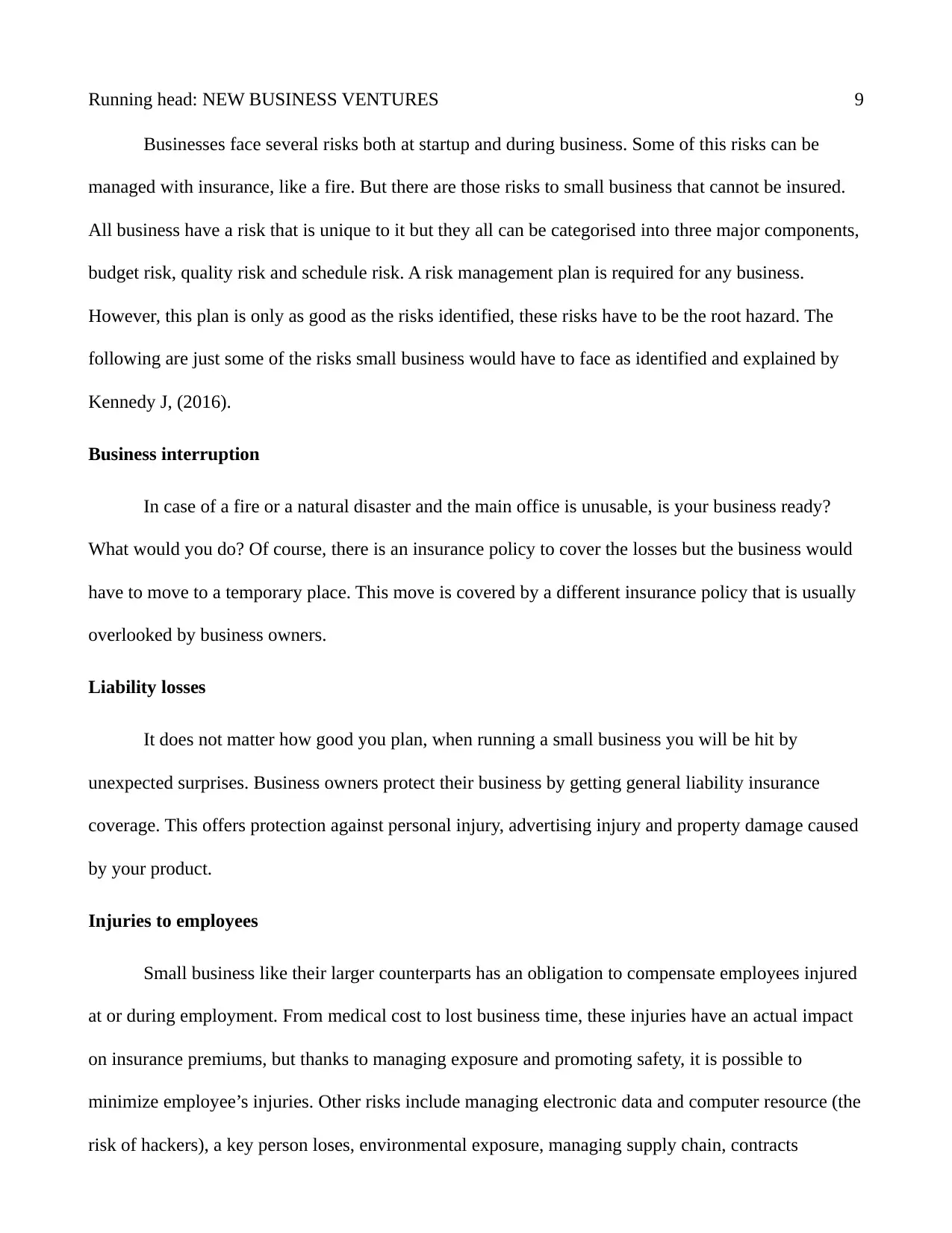
Running head: NEW BUSINESS VENTURES 9
Businesses face several risks both at startup and during business. Some of this risks can be
managed with insurance, like a fire. But there are those risks to small business that cannot be insured.
All business have a risk that is unique to it but they all can be categorised into three major components,
budget risk, quality risk and schedule risk. A risk management plan is required for any business.
However, this plan is only as good as the risks identified, these risks have to be the root hazard. The
following are just some of the risks small business would have to face as identified and explained by
Kennedy J, (2016).
Business interruption
In case of a fire or a natural disaster and the main office is unusable, is your business ready?
What would you do? Of course, there is an insurance policy to cover the losses but the business would
have to move to a temporary place. This move is covered by a different insurance policy that is usually
overlooked by business owners.
Liability losses
It does not matter how good you plan, when running a small business you will be hit by
unexpected surprises. Business owners protect their business by getting general liability insurance
coverage. This offers protection against personal injury, advertising injury and property damage caused
by your product.
Injuries to employees
Small business like their larger counterparts has an obligation to compensate employees injured
at or during employment. From medical cost to lost business time, these injuries have an actual impact
on insurance premiums, but thanks to managing exposure and promoting safety, it is possible to
minimize employee’s injuries. Other risks include managing electronic data and computer resource (the
risk of hackers), a key person loses, environmental exposure, managing supply chain, contracts
Businesses face several risks both at startup and during business. Some of this risks can be
managed with insurance, like a fire. But there are those risks to small business that cannot be insured.
All business have a risk that is unique to it but they all can be categorised into three major components,
budget risk, quality risk and schedule risk. A risk management plan is required for any business.
However, this plan is only as good as the risks identified, these risks have to be the root hazard. The
following are just some of the risks small business would have to face as identified and explained by
Kennedy J, (2016).
Business interruption
In case of a fire or a natural disaster and the main office is unusable, is your business ready?
What would you do? Of course, there is an insurance policy to cover the losses but the business would
have to move to a temporary place. This move is covered by a different insurance policy that is usually
overlooked by business owners.
Liability losses
It does not matter how good you plan, when running a small business you will be hit by
unexpected surprises. Business owners protect their business by getting general liability insurance
coverage. This offers protection against personal injury, advertising injury and property damage caused
by your product.
Injuries to employees
Small business like their larger counterparts has an obligation to compensate employees injured
at or during employment. From medical cost to lost business time, these injuries have an actual impact
on insurance premiums, but thanks to managing exposure and promoting safety, it is possible to
minimize employee’s injuries. Other risks include managing electronic data and computer resource (the
risk of hackers), a key person loses, environmental exposure, managing supply chain, contracts
⊘ This is a preview!⊘
Do you want full access?
Subscribe today to unlock all pages.

Trusted by 1+ million students worldwide
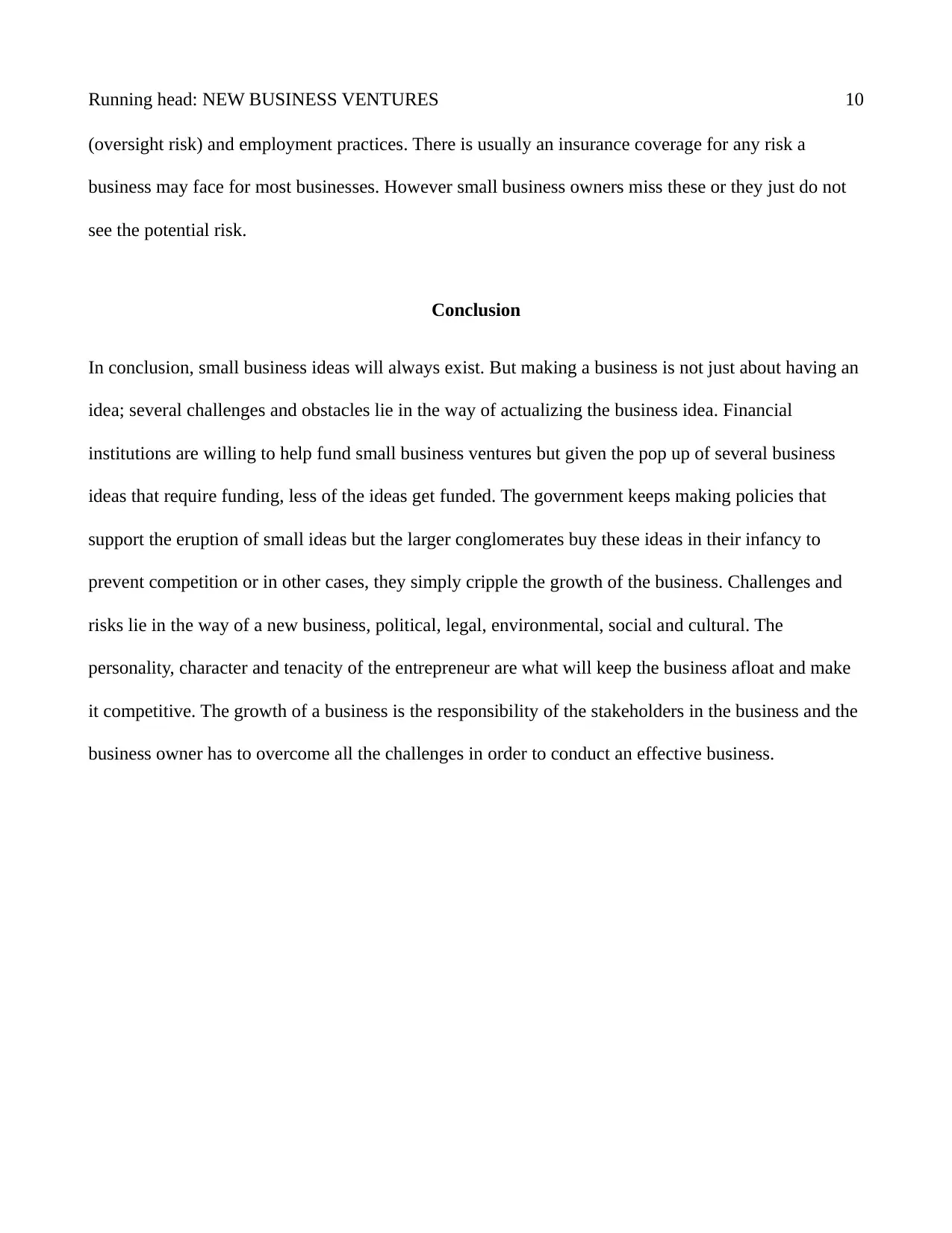
Running head: NEW BUSINESS VENTURES 10
(oversight risk) and employment practices. There is usually an insurance coverage for any risk a
business may face for most businesses. However small business owners miss these or they just do not
see the potential risk.
Conclusion
In conclusion, small business ideas will always exist. But making a business is not just about having an
idea; several challenges and obstacles lie in the way of actualizing the business idea. Financial
institutions are willing to help fund small business ventures but given the pop up of several business
ideas that require funding, less of the ideas get funded. The government keeps making policies that
support the eruption of small ideas but the larger conglomerates buy these ideas in their infancy to
prevent competition or in other cases, they simply cripple the growth of the business. Challenges and
risks lie in the way of a new business, political, legal, environmental, social and cultural. The
personality, character and tenacity of the entrepreneur are what will keep the business afloat and make
it competitive. The growth of a business is the responsibility of the stakeholders in the business and the
business owner has to overcome all the challenges in order to conduct an effective business.
(oversight risk) and employment practices. There is usually an insurance coverage for any risk a
business may face for most businesses. However small business owners miss these or they just do not
see the potential risk.
Conclusion
In conclusion, small business ideas will always exist. But making a business is not just about having an
idea; several challenges and obstacles lie in the way of actualizing the business idea. Financial
institutions are willing to help fund small business ventures but given the pop up of several business
ideas that require funding, less of the ideas get funded. The government keeps making policies that
support the eruption of small ideas but the larger conglomerates buy these ideas in their infancy to
prevent competition or in other cases, they simply cripple the growth of the business. Challenges and
risks lie in the way of a new business, political, legal, environmental, social and cultural. The
personality, character and tenacity of the entrepreneur are what will keep the business afloat and make
it competitive. The growth of a business is the responsibility of the stakeholders in the business and the
business owner has to overcome all the challenges in order to conduct an effective business.
Paraphrase This Document
Need a fresh take? Get an instant paraphrase of this document with our AI Paraphraser

Running head: NEW BUSINESS VENTURES 11
References
Batra, V. (2012). The State of Microfinance in India: Emergence, Delivery Models and Issues, Journal
of International Economics, 3(1), 0976-0792.
Covas, F., & Den Haan, W. J. (2012). The Role of Debt and Equity Finance Over the Business Cycle*
The Role of Debt and Equity Finance Over the Business Cycle. Economic Journal, 122(565),
1262-1286. doi:10.1111/j.1468-0297.2012.02528.x
Ghosh, A. & Moon, D. (2010). Corporate Debt Financing and Earnings Quality. Journal Of Business
Finance & Accounting, 37(5/6), 538-559. doi:10.1111/j.1468-5957.2010.02194.x
Heidrich, O., & Tiwary, A. (2013). Environmental appraisal of green production systems: Challenges
faced by small companies using life cycle assessment. International Journal Of Production
Research, 51(19), 5884-5896. doi:10.1080/00207543.2013.807372
Jha, J. K., & Singh, M. (2015). Human Resource (HR) &Social Challenges Faced by Microfinance in
India: A Framework. Indian Journal Of Industrial Relations, 50(3), 494-504.
Johnson, B. (2017). Small businesses launched on the eve of the Great Recession took a financial
beating. The ones that figured out how to adapt are thriving. Njbiz, 23.
Jung, S., Cho, S., & Roberts, R. K. (2015). The impact of government funding of poverty reduction
programmes. Papers In Regional Science, 94(3), 653-675. doi:10.1111/pirs.12089
Kennedy, J. (2016). Proposed Solutions to the Brand Protection Challenges and Counterfeiting Risks
Faced by Small and Medium Enterprises (SMEs). Journal Of Applied Security Research, 11(4),
450-468. doi:10.1080/19361610.2016.1210487
Lally, M., & Prasad, V. (2014). New Zealand finance companies and risk premiums. Accounting &
References
Batra, V. (2012). The State of Microfinance in India: Emergence, Delivery Models and Issues, Journal
of International Economics, 3(1), 0976-0792.
Covas, F., & Den Haan, W. J. (2012). The Role of Debt and Equity Finance Over the Business Cycle*
The Role of Debt and Equity Finance Over the Business Cycle. Economic Journal, 122(565),
1262-1286. doi:10.1111/j.1468-0297.2012.02528.x
Ghosh, A. & Moon, D. (2010). Corporate Debt Financing and Earnings Quality. Journal Of Business
Finance & Accounting, 37(5/6), 538-559. doi:10.1111/j.1468-5957.2010.02194.x
Heidrich, O., & Tiwary, A. (2013). Environmental appraisal of green production systems: Challenges
faced by small companies using life cycle assessment. International Journal Of Production
Research, 51(19), 5884-5896. doi:10.1080/00207543.2013.807372
Jha, J. K., & Singh, M. (2015). Human Resource (HR) &Social Challenges Faced by Microfinance in
India: A Framework. Indian Journal Of Industrial Relations, 50(3), 494-504.
Johnson, B. (2017). Small businesses launched on the eve of the Great Recession took a financial
beating. The ones that figured out how to adapt are thriving. Njbiz, 23.
Jung, S., Cho, S., & Roberts, R. K. (2015). The impact of government funding of poverty reduction
programmes. Papers In Regional Science, 94(3), 653-675. doi:10.1111/pirs.12089
Kennedy, J. (2016). Proposed Solutions to the Brand Protection Challenges and Counterfeiting Risks
Faced by Small and Medium Enterprises (SMEs). Journal Of Applied Security Research, 11(4),
450-468. doi:10.1080/19361610.2016.1210487
Lally, M., & Prasad, V. (2014). New Zealand finance companies and risk premiums. Accounting &
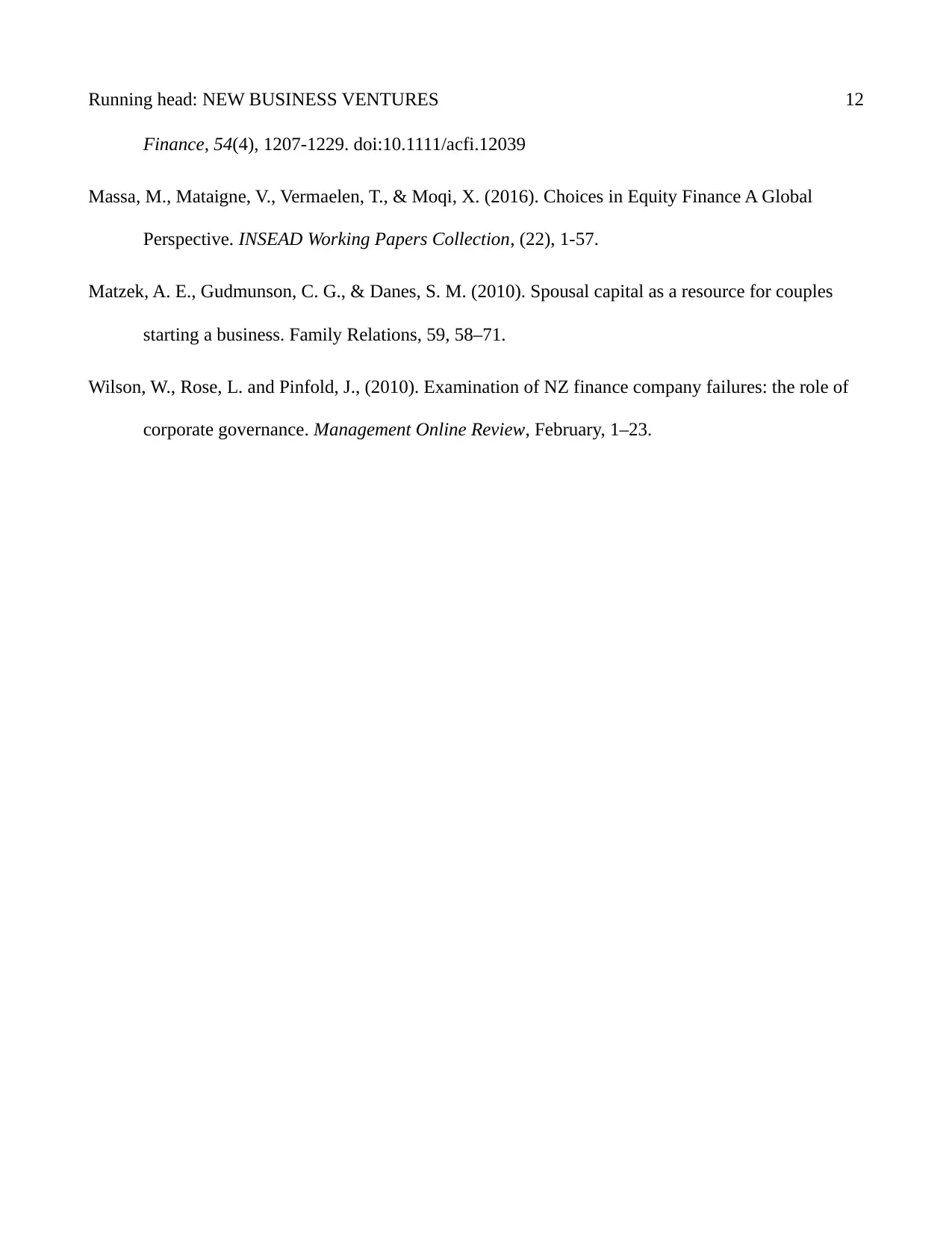
Running head: NEW BUSINESS VENTURES 12
Finance, 54(4), 1207-1229. doi:10.1111/acfi.12039
Massa, M., Mataigne, V., Vermaelen, T., & Moqi, X. (2016). Choices in Equity Finance A Global
Perspective. INSEAD Working Papers Collection, (22), 1-57.
Matzek, A. E., Gudmunson, C. G., & Danes, S. M. (2010). Spousal capital as a resource for couples
starting a business. Family Relations, 59, 58–71.
Wilson, W., Rose, L. and Pinfold, J., (2010). Examination of NZ finance company failures: the role of
corporate governance. Management Online Review, February, 1–23.
Finance, 54(4), 1207-1229. doi:10.1111/acfi.12039
Massa, M., Mataigne, V., Vermaelen, T., & Moqi, X. (2016). Choices in Equity Finance A Global
Perspective. INSEAD Working Papers Collection, (22), 1-57.
Matzek, A. E., Gudmunson, C. G., & Danes, S. M. (2010). Spousal capital as a resource for couples
starting a business. Family Relations, 59, 58–71.
Wilson, W., Rose, L. and Pinfold, J., (2010). Examination of NZ finance company failures: the role of
corporate governance. Management Online Review, February, 1–23.
⊘ This is a preview!⊘
Do you want full access?
Subscribe today to unlock all pages.

Trusted by 1+ million students worldwide
1 out of 12
Related Documents
Your All-in-One AI-Powered Toolkit for Academic Success.
+13062052269
info@desklib.com
Available 24*7 on WhatsApp / Email
![[object Object]](/_next/static/media/star-bottom.7253800d.svg)
Unlock your academic potential
Copyright © 2020–2025 A2Z Services. All Rights Reserved. Developed and managed by ZUCOL.





